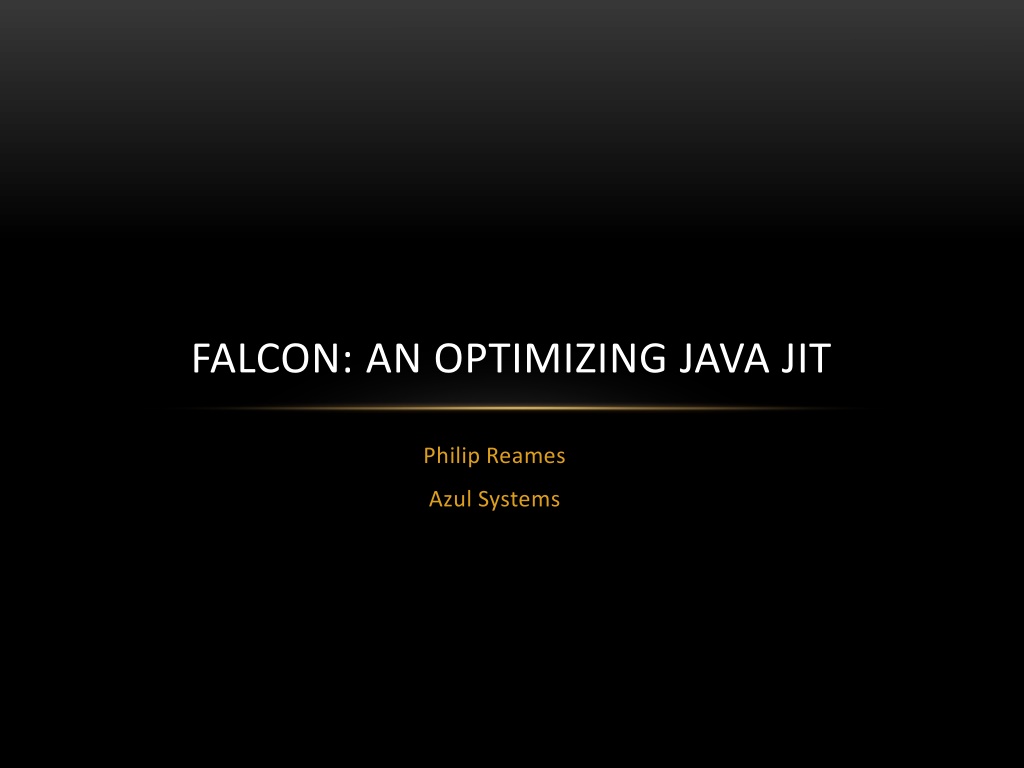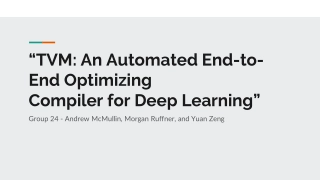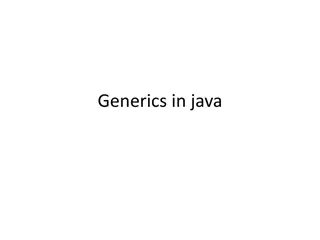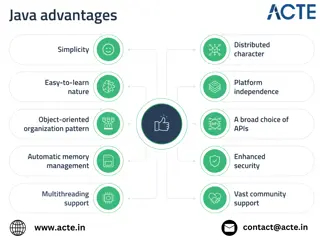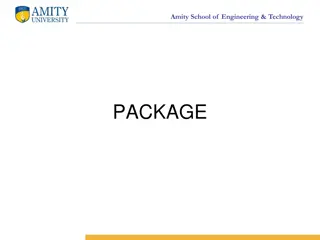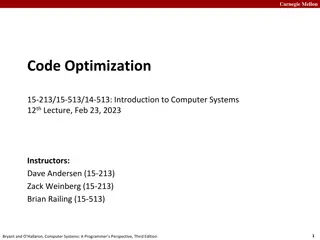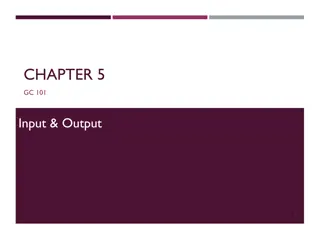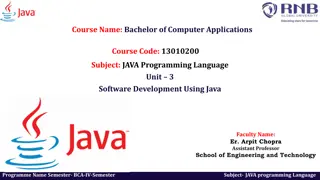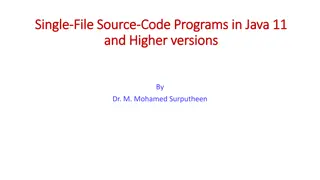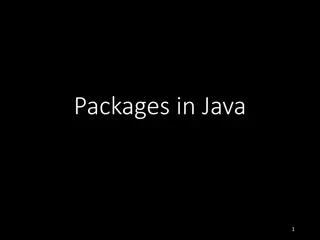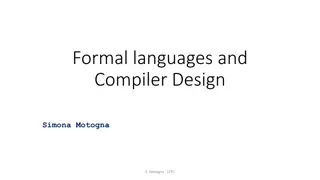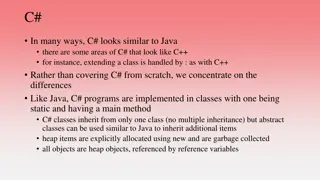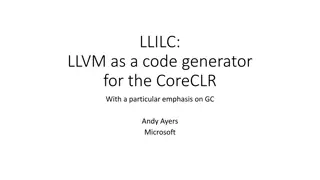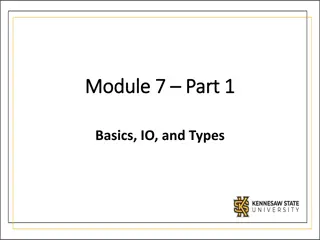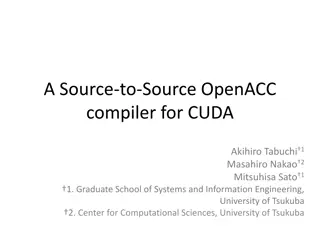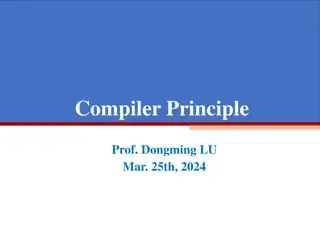Falcon: An Optimizing Java JIT Compiler Overview
Explore Falcon, an LLVM-based just-in-time compiler for Java bytecode developed by Azul Systems. Learn why using LLVM to build a JIT compiler is beneficial, address common objections, and dive into the technical and process lessons learned through its development timeline.
Download Presentation

Please find below an Image/Link to download the presentation.
The content on the website is provided AS IS for your information and personal use only. It may not be sold, licensed, or shared on other websites without obtaining consent from the author.If you encounter any issues during the download, it is possible that the publisher has removed the file from their server.
You are allowed to download the files provided on this website for personal or commercial use, subject to the condition that they are used lawfully. All files are the property of their respective owners.
The content on the website is provided AS IS for your information and personal use only. It may not be sold, licensed, or shared on other websites without obtaining consent from the author.
E N D
Presentation Transcript
FALCON: AN OPTIMIZING JAVA JIT Philip Reames Azul Systems
AGENDA Intro to Falcon Why you should use LLVM to build a JIT Common Objections (and why they re mostly wrong) 2
WHAT IS FALCON? Falcon is an LLVM based just-in-time compiler for Java bytecode. Shipping on-by-default in the Azul Zing JVM. Available for trial download at: www.azul.com/zingtrial/ 3
THIS TALK IS ABOUT LESSONS LEARNED, BOTH TECHNICAL AND PROCESS 4
ZING VM BACKGROUND A hotspot derived JVM with an awesome GC (off topic) Multiple tiers of execution Tier1 Compiler Tier2 Compiler Interpreter Rapidly generated code to collect profiling quickly Run once bytecode and rare events Compile hot methods for peak performance 5
BUSINESS NEED The existing C2 compiler is aging poorly vectorization (a key feature of modern x86_64) is an afterthought very complicated codebase; "unpleasant" bug tails the norm difficult to test in isolation Looking to establish a competitive advantage Long term goal is to outperform competition Velocity of performance improvement is key 6
DEVELOPMENT TIMELINE April 2014 Proof of concept completed (in six months) Feb 2015 Mostly functionally complete April 2016 Alpha builds shared with selected customers Dec 2016 Product GA (off by default) April 2017 On by default Team size: 4-6 developers, ~20 person years invested 7
TEAM EFFORT Falcon Development Bean Anderson Chen Li Igor Laevsky Daniel Neilson Serguei Katkov Daniil Suchkov Leela Venati Nina Rinskaya Philip Reames Sanjoy Das Artur Pilipenko Anna Thomas Maxim Kazantsev Michael Wolf Kris Mok + VM development team + Zing QA + All Azul (E-Staff, Sales, Support, etc..) 8
Zing 17.08 vs Oracle 8u121 200% 180% 160% 140% 120% 100% 80% 60% 40% 20% 0% Various application benchmarks + SPECjvm + Dacapo Collected on a mix of haswell and skylake machines 9
WHY YOU SHOULD USE LLVM TO BUILD A JIT Proven stability, widespread deployments Active developer community, support for new micro-architectures Proven performance (for C/C++) Welcoming to commercial projects 10
COMMON OBJECTIONS "LLVM doesn't support X LLVM is a huge dependency" "We added an LLVM backend; it produced poor code" "LLVM generates too much code" "LLVM is a slow JIT My language has feature X (which requires a custom compiler) 11
Objection 1 of 6 LLVM DOESN'T SUPPORT X 12
FIRST, A BIT OF SKEPTICISM... Is this something you can express in C? If so, LLVM supports it. e.g. deoptimization via spill to captured on-stack buffer buf = alloca( ); buf[0] = local_0; a->foo(buf, actual_args ) The real question, is how well is it supported? 13
FUNCTIONAL CORNER-CASES If you can modify your ABI (calling conventions, patching sequences, etc..), your life will be much easier. You will find a couple of important hard cases. Ours were: anchoring" for mixed stack walks red-zone arguments to assembler routines support for deoptimization both checked and async GC interop 14
BE WARY OF OVER DESIGN Common knowledge that quality of safepoint lowering matters. gc.statepoint design Major goal: allow in register updates Topic of 2014 LLVM Dev talk 2+ person years of effort It turns out that hot safepoints are inliner bug. 15
GET TO FUNCTIONAL CORRECTNESS FIRST Priority 1: Implement all interesting cases, get real code running Priority 2: Add tests to show it continues working Design against an adversarial optimizer. Be wary of over-design, while maintaining code quality standards. See backup slides for more specifics on this topic. 16
Objection 2 of 6 LLVM IS A HUGE DEPENDENCY 17
Potentially a real issue, but depends on your definition of large. From our shipping product: libJVM = ~200mb libLLVM = ~40mb So, 20% code size increase. 18
Objection 3 of 6 WE ADDED AN LLVM BACKEND; IT PRODUCED POOR CODE 19
IMPORTANCE OF PROFILING Tier 1 collects detailed profiles; Tier 2 exploits them 25% or more of peak application performance 20
PRUNE UNTAKEN PATHS Handle rare events by returning to lower tier, reprofiling, and then recompiling. Rare Events Interpreter Tier1 Code Tier2 Code %ret = call i32 @llvm.experimental.deoptimize() ["deopt"(..)] ret i32 %ret 21
PREDICATED DEVIRTUALIZATION switch (type(o)) case A: A::foo(); case B: B::foo(); default: @deoptimize() [ deopt ( )] switch (type(o)) case A: A::foo(); case B: B::foo(); default: o->foo(); Critical for Java, where everything is virtual by default 22
IMPLICIT NULL CHECKS %is.null = icmp eq i8* %p, null br i1 %is.null, label %handler, label %fallthrough, !make.implicit !{} test rax, rax jz <handler> rsi = ld [rax+8] rsi = ld [rax+8] fault_pc __llvm_faultmaps[fault_pc] -> handler handler: call @__llvm_deoptimize 23
LOCAL CODE LAYOUT branch_weights for code layout Hot cold hot cold hot cold hot hot hot cold cold cold Sources of slow paths: GC barriers, safepoints handlers for builtin exceptions result of code versioning 50%+ of total code size 24
GLOBAL CODE LAYOUT Best to put cold code into it's own section func1-hot func2-hot func3-hot func1-cold func2-cold func3-cold func1-hot func1-cold func2-hot func2-cold func3-hot func3-cold See: LLVM back end for HHVM/PHP, LLVM Dev Conf 2015 25
EXPLOITING SEMANTICS LLVM supports a huge space of optional annotations Performance Analysis Both metadata and attributes ~6-12 month effort Add Annotation Root Cause Issue Fix Uncovered Miscompiles 26
DEFINING A CUSTOM PASS ORDER legacy::PassManager PM; PM.add(createEarlyCSEPass()); ... PM.run(Module) Requires careful thought and experimentation. MCJIT's OptLevel is not what you want. PassManagerBuilder is tuned for C/C++! May expose some pass ordering specific bugs 27
EXPECT TO BECOME AN LLVM DEVELOPER You will uncover bugs, both performance and correctness You will need to fix them. Will need a downstream process for incorporating and shipping fixes. See backup slides for more specifics on this topic. 28
STATUS CHECK We've got a reasonably good compiler for a c-like subset of our source language. We're packaging a modified LLVM library. This is further than most projects get. 29
QUICK EXAMPLE public int intsMin() { int min = Integer.MAX_VALUE; for (int i = 0; i < a_I.length; i++) { min = min > a_I[i] ? a_I[i] : min; } return min; } 4x faster than competition on Intel Skylake 30
Objection 4 of 6 "LLVM GENERATES TOO MUCH CODE" 31
CALLING ALL LLVM DEVELOPERS... We regularly see 3-5x larger code compared to C2. Partly as a result of aggressive code versioning. But also, failure to exploit: mix of hot and cold code, need selective Oz lots and lots of no-return paths gc.statepoint lowering vs reg-alloc code versioning via deopt (unswitch, unroll, vectorizer) 32
Objection 5 of 6 LLVM IS A SLOW JIT 33
Absolutely. LLVM is not suitable for a first tier JIT. That's not what we have or need. We use the term "in memory compiler" to avoid confusion. 34
SYSTEM INTEGRATION VM infrastructure moderates impact The tier 2 compiler sees a small fraction of the code. Background compilation on multiple compiler threads. Prioritized queueing of compilation work Hotness driven fill-in of callee methods This stuff is standard (for JVMs). Nothing new here. 35
IN PRACTICE, MOSTLY IGNORE-ABLE Typical compile times around 100ms. Extreme cases in the seconds to low minute range. At the extreme, that's (serious) wasted CPU time, but nothing else. 36
WAIT, YOU DO WHAT? There are cases where this isn't good enough. a popular big-data analytics framework spawns a JVM per query multi-tenancy environments can spawn 1000s of JVMs at once Improving compile time is hard. So what do we do? 37
CACHED COMPILES Reuse compiled code across runs. Profiling continues to apply. After all, our "in memory compiler" does produce normal object files. No decrease in peak performance. Planned to ship in a future version of Zing. Credit for inspiration goes to the Pyston project and their article "Caching object code". https://blog.pyston.org/2015/07/14/caching-object-code 38
Objection 6 of 6 MY LANGUAGE HAS FEATURE X (WHICH REQUIRES A CUSTOM COMPILER) 39
LANGUAGE SPECIFIC DEFICIENCIES LLVM has been tuned for certain languages The more different your language, the more work needed. For Java, our key performance problems were: range checks null checks devirtualization & inlining type based optimizations deoptimization 40
DO YOU ACTUALLY HAVE A PROBLEM? Try the naive version, seriously try it! Very useful to try different C++ implementations requires good knowledge of Clang may find a viable implementation strategy may provide insight into what optimizer finds hard Check to see if existing metadata/attributes are relevant 41
CUSTOM ATTRIBUTES/METADATA Is there a single key missing fact? Or a small set thereof? A lot of advantages: Factoring for long term branching May be upstreamable Examples from our tree: LICM isGuaranteedToExecute "allocation-site" "deopt-on-throw" "known-value" "java-type"= XYZ Easy to functionally test Serialization 42
METADATA HEALING Optimizer tends to strip metadata it doesn't understand. Don't try to change this Need a mechanism to "heal" previously stripped metadata See backup slides for more on this topic 43
CALLBACKS Narrow interface between optimizer and containing runtime Optional<FieldInfo> getKnownValueKeyDependent(llvm::LLVMContext &C, KnownValueID BaseObj, int64_t Offset, uint64_t Size); 44
CALLBACKS Primarily used for metadata healing But also useful for type system specific optimizations Resist temptation to add them freely. Each one should be strongly and continuously justified. We have 24 total. And that's too many. Optimizer can visit dead code (Critically Important) Fuzz this interface. Seriously, fuzz it! 45
IMPLICATIONS FOR REPLAY Replay is an absolutely essential debugging and diagnostic tool $ opt O3 -S input.ll To preserve replay w/callbacks, need a query-log mechanism. $ opt O3 -S input.ll --read-query-log-from-file=input.ll.queries 46
EMBEDDED HIGH LEVEL IR "Abstraction" functions Opaque by default to the optimizer Can be first class citizens with builtin knowledge Useful for building certain classes of high level optimizations declare i8 addrspace(1)* @azul.resolve_virtual(i8 addrspace(1)* %receiver, i64 %vtable_index) nounwind noinline readonly "late-inline"="2" "gc-leaf-function" 47
EMBEDDED HIGH LEVEL IR Enable high level transforms such as: devirtualization object elision allocation sinking & partial escape analysis lock coarsening & elision Most of the above expressed as custom passes See backup slides for discussion of the tradeoffs around custom passes 48
A (SLIGHT) CHANGE IN VIEW ON ABSTRACTIONS Useful for rapid evolution and prototyping But each is an optimization barrier until lowered As few as you can reasonably manage long term Lower early in the pipeline Minimize number of unique lowering points 49
CONCLUSION For the right use case, LLVM can be used to build a production quality JIT which is performance competitive with state of the art. 50
